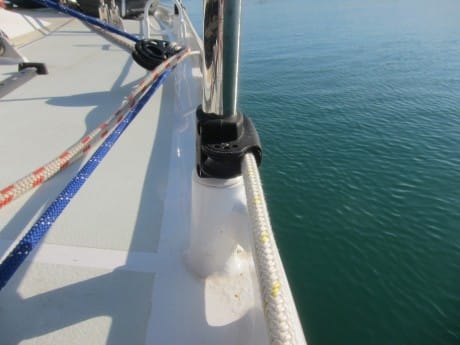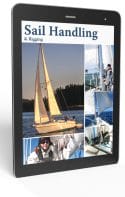
The old saying that ‘if a job is easy, you’ll do it’, is a good one that we have tried to bring to bear at all times when improving our Ovni 435 Pèlerin. If the job’s difficult, you’ll delay it until it’s beyond inevitable and then it can become a hardship. And nowhere is that more true than when reefing, especially if you’re alone on watch.
As Delivered
When our boat was delivered some of the deck gear was less than perfect in our view; a simple case in point being the line controls for the roller reefing gear. This had small solid pulley blocks, and was led to the winch via a jammer to secure it (the original lasted a week before the lever broke off!). The friction in the system was such that the line had to be led to a winch every time we needed to reef the yankee (jib topsail), which meant that we lost the ‘feel’ that gives warning of a jam or snarl up at the drum end when the line is handled manually. And once you start cranking away on a big winch it’s easy to make things worse—multiply this x 4 with electric or hydraulic winches. So we shifted the blocks around a bit, replaced the jammer with a more robust model and then went sailing, fully intending to sort it properly when the right idea appeared.



Colin, Nice set up. I just ordered a few of the Harken “outside” blocks based on your post.
One additional thing we did was go to very low-stretch furling line. (We waited for the annual line sale.) We did this because of a couple of situations over the years where a reef with a lot of wind pressure in the sail resulted in a line lock on the drum that required a trip forward to clear.
The other thing we did was use line which has the same UV protection in the core as the sheath. We removed the sheath back to just ahead of the location of your spin lock. This loads the drum with smaller diameter line which also reduces the line lock problem. 92% of the line strength is in the core.
Chris
Hi Chris
I, too, have had the occasional snarl up in a drum under heavy tension and snatch loads in bad weather – a royal pain, and one reason why I prefer open drum rollers where it is easier to get at the line. So I’m very intrigued with your idea, which makes a lot of sense to me, and is something we’ll definitely look into when the times comes to replace the line – thanks!
Best wishes
Colin
Colin, if you give this a try, I should add we put chafe protection tape around the unsheathed line where it lingers in the stanchion fairleads and turning block forward. Chris
This looks like a very tidy solution. Thanks for sharing it with us. I punched a stauchion base through the deck once because the furling line turning block was mounted onto it… The base was very dodgy anyway, but as it was over my bunk everything got very wet.
Your stanchion base looks really solid. But just thought I better mention it in case anyone with an old fiberglass boat tries it…
On Snow Petrel I run my furling line over the cabintop, and onto a winch beside the companion way, a more direct lead on Snowpetrel and no need for a turning block, and someone can winch it in without leaving the companionway! But I could probably still reduce the friction even further by getting some good roller bearing blocks.
Hi Chris, the line stowage on the drum has been a big problem for me in the past as well, but now I have a huge alloy drum, that can take all the 10mm rope I want, less stretch, nice to handle and strong… Also the big drum means less effort to roll up the sail, and less tangles. It does look a bit chunky but this suits Snow Petrel.
I normally quickly run off, blanket the headsail behind the main (still sheeted in) and roll up a chunk of sail by hand; it’s quick and low stress, and requires no winching of furling lines or sheets. Curious to know how most of you reef the headsail? Do you let it flog, winch it or blanket it?
For more info see http://snowpetrelsailing.blogspot.com/2011/02/roller-reefing-and-misguided-mascochism.html
Hi Ben
Fortunately for us everything is welded and double-tough!
Good roller blocks always help, and I’m definitely with you on having a large diameter roller drum – makes a lot of sense.
We follow the same drill you describe when reefing, except in light winds, or when there is no room to bear away – we always try to avoid the sail flogging, which puts a lot of strain on the gear, and is hardly likely to prolong the life of the (expensive) sail.
Best wishes
Colin
Ben, for us, it’s one of those “it depends” answers. We prefer not to let sails flog unless the boat is at risk if we don’t. With the jib, a little bit of wind pressure in the sail also allows for a tight furl. If we have to use the winch, one of us keeps an eye on the furling drum to make sure it turns as the winch does. We’ve seen forestay tangs bent and lower furling units damaged from cranking a jammed unit. With the inner staysail, we decided against furling for now.
Big question:
How much did you spend on this Harken upgrade to your vessel?
Thanks,
Richard
Hi Richard
We bought the kit a couple of years ago, and it probably cost us around US$400 total. If we had fitted it from new of course we’d have saved the cost of the original kit, but that wasn’t an option at the time. But for the big improvement it has made for short handed sailing it was money well spent, we feel.
Kind regards
Colin
Hi Colin, I am looking at doing a similar conversion currently the line is secured to a horn cleat, nice and simple but awkward to pull in a little when under load. I use a ratcheting pulley on the aft quarter to pull it in. which is fantastic. Looks like you have used a XTS clutch rather than a XA as stated in your article. Question: Can you release this under load (obviously controlling the ease with some sort of friction for example a turn on the winch drum, or in my case the ratcheting pulley. Cheers Pete
The German rope manufacturer Liros makes a dedicated roller furling line that has two sections, one with full diameter for use in the clutch and on the winch and one with reduced diameter for use en route to the foredeck and on the drum. It is Dyneema and comes in a fixed length that needs to be carefully cut on both ends so that the small diameter section does not reach the clutch and winch when fully furled (add a good reserve, I would use 3m/10ft, as the furl of the sail will be much tighter in strong wind which results in more furling line coming off the drum when furled all the way in. Leave several extra turns on the drum when testing in port for the same reason.
Play around and test for a while, then cut, as this is too expensive to be thrown away and you don’t want the small diameter section in the clutch or on the winch.
The build of the line is top notch, comparable to their flagship product “Regatta 2000” which is the best line I have and know.
The change in diameter is abrupt, over 1/2 foot only, not a slow taper as on a racer’s spi sheet, but that’s no problem in my eyes.
The Spinlock XTS clutch can be opened under load but slow slipping of the line, of course, requires a turn or two on the winch.